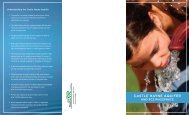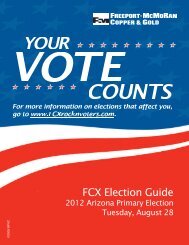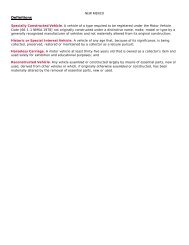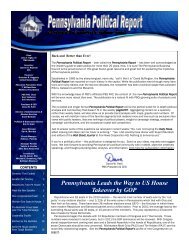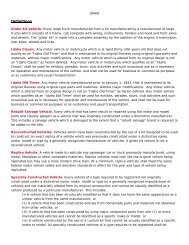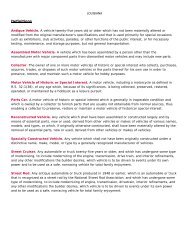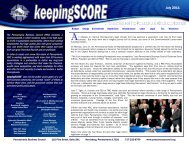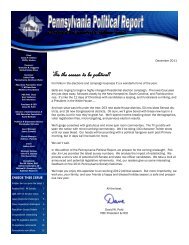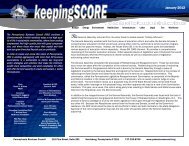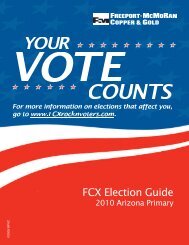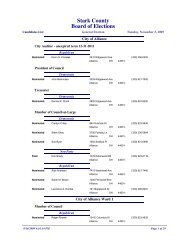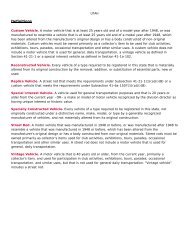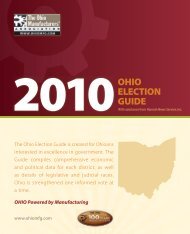TENNESSEE Definitions - BIPAC
TENNESSEE Definitions - BIPAC
TENNESSEE Definitions - BIPAC
You also want an ePaper? Increase the reach of your titles
YUMPU automatically turns print PDFs into web optimized ePapers that Google loves.
Equipment Exemptions<br />
From Tennessee Code:<br />
Title 55 Motor and Other Vehicles<br />
Chapter 9 Equipment--Lighting Regulations<br />
Part 4 --Lighting Regulations<br />
Tenn. Code § 55-9-402 (2010)<br />
55-9-402. Lights required on motor vehicles -- Exceptions -- Regulations as to color, type and<br />
visibility distance.<br />
(a) (1) Every motor vehicle other than a motorcycle, road roller, road machinery or farm tractor shall<br />
be equipped with at least two (2) and not more than four (4) headlights, with at least one (1) on each side<br />
of the front of the motor vehicle. No nonemergency vehicle shall operate or install emergency flashing<br />
light systems, such as strobe, wig-wag, or other flashing lights within the headlight assembly or grill area<br />
of the vehicle; provided, however, that a school bus may operate a flashing, wig-wag lighting system<br />
within the headlight assembly of the vehicle when the vehicle's visual stop signs are actuated for receiving<br />
or discharging school children.<br />
(2) Auxiliary road lighting lamps may be used, but not more than two (2) of the lamps shall be lighted<br />
at any one (1) time in addition to the two (2) required headlights.<br />
(3) No spotlight or auxiliary lamp shall be so aimed upon approaching another vehicle that any part of<br />
the high intensity portion of the beam therefrom is directed beyond the left side of the motor vehicle upon<br />
which the spotlight or auxiliary lamp is mounted, nor more than one hundred feet (100') ahead of the<br />
motor vehicle.<br />
(b) (1) Every motor vehicle shall be equipped with two (2) red tail lamps and two (2) red stoplights on<br />
the rear of the vehicle, and one (1) tail lamp and one (1) stoplight shall be on each side, except that<br />
passenger cars manufactured or assembled prior to January 1, 1939, trucks manufactured<br />
or assembled prior to January 1, 1968, and motorcycles and motor-driven cycles shall have at least one<br />
(1) red tail lamp and one (1) red stoplight. No non-emergency vehicle shall operate or install emergency<br />
flashing light systems such as strobe, wig-wag, or other flashing lights in tail light lamp, stoplight area, or<br />
factory installed emergency flasher and backup light area; provided, however, that the foregoing<br />
prohibition shall not apply to the utilization of a continuously flashing light system. For the purposes of<br />
this part, "continuously flashing light system" means a brake light system in which the brake lamp pulses<br />
rapidly for no more than five (5) seconds when the brake is applied, and then converts to a continuous<br />
light as a normal brake lamp until the time that the brake is released.<br />
(2) The stoplight shall be so arranged as to be actuated by the application of the service or foot brake<br />
and shall be capable of being seen and distinguished from a distance of one hundred feet (100') to the<br />
rear of a motor vehicle in normal daylight, but shall not project a glaring or dazzling light.<br />
(3) The stoplight may be incorporated with the tail lamp.<br />
(4) Motor vehicle tail light lamps may operate as following:<br />
(A) A white backup light operates when the motor vehicle is in reverse;<br />
(B) When the driver is in a panic stop condition going forward, the backup lamp pulses or flashes red;<br />
and<br />
(C) Upon normal stops of the motor vehicle, there is no action by the backup light.<br />
(c) Each lamp and stoplight required in this section shall be in good condition and operational.<br />
(d) (1) No vehicle operated in this state shall be equipped with any flashing red or white light or any<br />
combination of red or white lights that displays to the front of the vehicle except school buses, a<br />
passenger motor vehicle operated by a rural mail carrier of the United States postal service while<br />
performing the duties of a rural mail carrier, authorized law enforcement vehicles only when used in



